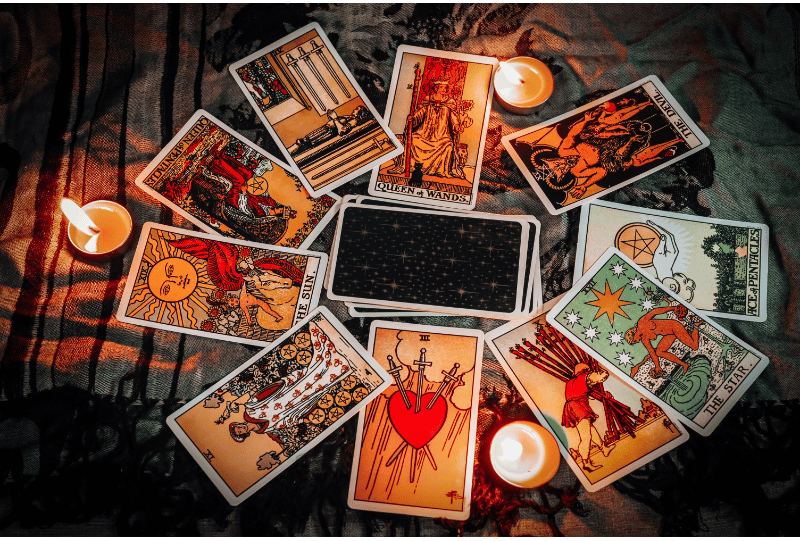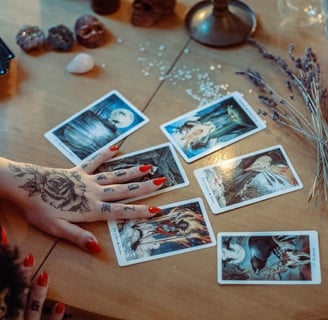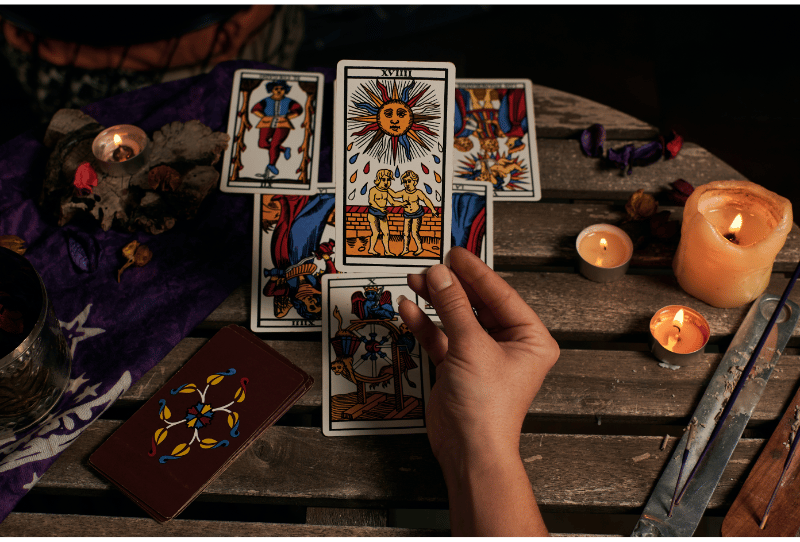Understanding Tarot Cards: A Comprehensive Guide to Their Meaning and Purpose
Tarot cards have fascinated people for centuries, offering insights into the past, present, and future. These mystical cards are not just tools for fortune-telling but also serve as a means of self-reflection and personal growth. In this blog post, we will explore what tarot cards are, their purpose, and provide a comprehensive list of the tarot cards along with their meanings.
PSYCHIC READINGS AND EXPERIENCES


Disclosure: This post may contain affiliate links, meaning I get a commission if you decide to make a purchase through my links, at no cost to you
Get your FREE personalized video Moon Reading - Click Here
Introduction
Tarot cards have long fascinated humanity, weaving a tapestry of mystery, intuition, and insight through the ages. Originating in the 15th century as a mere card game in parts of Europe, the tarot underwent a remarkable transformation into a profound tool for divination by the 18th century. This evolution marks a shift from the tarot's mundane beginnings to its current status as a mirror to the soul, offering guidance, wisdom, and a glimpse into the unseen forces that shape our lives.
The purpose of this guide is to demystify the tarot, making it accessible to newcomers and enriching the knowledge of seasoned practitioners. We'll explore the structure of a tarot deck, the significance of its cards, and how to interpret them in readings. Additionally, we'll cover common tarot spreads and their uses, delve into the ethical considerations in tarot reading, and ultimately, provide a comprehensive understanding of tarot's meaning and purpose.
As we embark on this journey, keep in mind that the tarot is a tool for personal growth, introspection, and understanding the complexities of human life. Its true power lies not in predicting the future but in its ability to illuminate the present, guiding us through life's challenges with wisdom and empathy.
With this foundation, let's delve into the structure of a tarot deck, beginning with the intricate dance of the Major and Minor Arcanas, which forms the heart of a tarot reading.
The Structure of a Tarot Deck
A standard tarot deck is a profound toolkit of 78 cards, each brimming with symbolism, history, and potential. The deck is divided into two main categories: the Major Arcana and the Minor Arcana, with each card holding its unique significance and story.
Major Arcana: The Fool’s Journey, Key Themes, and Significance
The Major Arcana consists of 22 cards, starting with The Fool, numbered 0, and ending with The World, numbered 21. These cards represent significant life themes, spiritual lessons, and karmic influences. The journey through the Major Arcana is often referred to as "The Fool's Journey," symbolizing an individual's journey through life, encompassing trials, triumphs, and the lessons learned along the way.
The Fool symbolizes new beginnings, innocence, and a leap of faith.
The Magician represents manifestation, resourcefulness, and power.
The High Priestess stands for intuition, unconscious knowledge, and mystery.
The Empress and The Emperor embody femininity, fertility, abundance, authority, and stability, respectively.
Each card in the Major Arcana carries deep symbolic meaning, reflecting pivotal moments in our life's journey where significant change and insight are possible.
Minor Arcana: The Four Suits, Their Elements, and General Meanings
The Minor Arcana comprises 56 cards, further divided into four suits: Cups, Pentacles, Swords, and Wands. Each suit corresponds to an element and aspect of human experience, offering nuanced insights into daily matters.
Cups (Water) delve into emotions, relationships, and connections.
Pentacles (Earth) focus on material aspects, such as work, finances, and health.
Swords (Air) reflect the realm of thought, conflict, and power.
Wands (Fire) symbolize creativity, action, and passion.
Within each suit, there are ten numbered cards and four court cards (Page, Knight, Queen, King), each representing different facets of human experience influenced by their respective elements.
Court Cards and Their Roles in Readings
The court cards often represent people in the querent's life or aspects of the querent's own personality. They can indicate characteristics, behaviors, or influences relevant to the situation at hand.
Pages signify messages, youthfulness, or the beginning stages of understanding.
Knights represent action, movement, and the pursuit of goals.
Queens embody maturity, nurturing energy, and introspection.
Kings stand for authority, structure, and control over one's environment.
Understanding the roles and attributes of these cards within the context of a reading can provide profound insights into personal dynamics and life situations.
Interpreting Tarot Cards
The art of tarot reading hinges on interpretation, a dance between the reader's intuition and the traditional meanings ascribed to the cards. Each reading is a unique conversation, not just between the reader and the querent but also involving the cards themselves, each offering its voice to the narrative being woven.
The Importance of Intuition and Personal Connection
While the traditional meanings of tarot cards provide a solid foundation, the true essence of a reading lies in the reader's ability to tap into their intuition. This intuitive connection transforms the reading from a mere recitation of meanings into a deeply personal and relevant exploration of the querent's life and challenges. It's the reader's personal connection to the cards that allows for the translation of symbols into specific, contextual advice and insight.
Traditional Meanings vs. Personal Interpretations
Each tarot card carries with it a range of meanings that have been distilled over centuries of practice and scholarship. However, these meanings are not fixed; they serve as a starting point from which the reader draws, adding layers of personal interpretation based on their intuition, the querent's situation, and the question at hand. This flexibility is what makes tarot reading a dynamic and fluid form of divination, capable of addressing the multifaceted aspects of human experience.
The Lovers might traditionally indicate love, harmony, or a significant relationship. In a personal context, it could suggest a decision to be made, the harmony within oneself, or the dynamics of a partnership.
The Tower, often feared for its association with sudden change or upheaval, can also be interpreted as a necessary destruction of outdated structures, paving the way for renewal and rebuilding.
The Role of Context in Readings (Question, Spread, Card Position)
Context is king in tarot readings. The same card can unveil different facets of its meaning depending on the question asked, the spread used, and its position within the spread. A card's interpretation is deeply influenced by its neighbors and the overall theme of the reading.
In a career-focused reading, The Eight of Pentacles might emphasize dedication to craftsmanship and the importance of attention to detail.
In a relationship context, the same card could suggest focusing on the work required to build and maintain a strong partnership.
Brief Examples of Card Interpretations
To illustrate the interplay of traditional meanings, personal intuition, and context, let's consider a few brief examples:
The High Priestess in a position representing the past might suggest that intuition or secrets played a significant role in the querent's previous circumstances. It could also indicate a time of inner reflection or a need to listen more deeply to one's inner voice.
The Ten of Swords appearing in a future position might alarm some, but it could also be interpreted as the end of a difficult phase, signaling that the worst is over and it's time to move forward, leaving behind what no longer serves.
These examples underscore the multifaceted nature of tarot cards, revealing how their meanings shift and evolve with each reading's specific circumstances.
Common Tarot Spreads and Their Uses
Tarot spreads range from the simple and straightforward to the complex and comprehensive. Each spread is tailored to different types of questions or the level of detail the querent seeks. Here, we'll examine a few common spreads and discuss how and when they might be used.
One-card Daily Draw: Simplicity and Guidance
The one-card daily draw is perhaps the simplest form of tarot spread, perfect for beginners or those seeking a quick piece of guidance for the day ahead. Despite its simplicity, a single card can offer profound insights, serving as a focal point for meditation or a prompt for self-reflection.
Purpose: Daily inspiration, clarity for the day, or a quick answer to a specific question.
How to Use: Shuffle the deck while focusing on your day or question, and draw a single card.
Three-card Spread: Past, Present, and Future
The three-card spread is versatile and widely used, offering a snapshot of the querent's journey through time regarding a particular situation.
Positions: Past (influences or events that have led to the present), Present (current situation or challenge), Future (possible outcome based on the present trajectory).
Purpose: To provide insight into the progression of a situation, highlighting influences and potential outcomes.
Celtic Cross: Comprehensive Analysis of Situations
The Celtic Cross is one of the most detailed and informative spreads, consisting of ten positions that cover a wide range of aspects of the querent's life or question.
Positions: Cover aspects such as the present situation, challenges, past influences, future possibilities, and potential outcomes.
Purpose: To offer a deep and comprehensive overview of a complex situation, identifying underlying factors, potential challenges, and guidance for moving forward.
Get your FREE personalized video Moon Reading - Click Here
Relationship Spreads: Understanding Dynamics and Outcomes
Relationship spreads are designed to examine the dynamics between individuals, offering insights into feelings, potential conflicts, and the overall health of the relationship.
Typical Layout: Varies, but often includes positions representing each person's feelings, the relationship's current state, challenges, and potential future.
Purpose: To provide clarity on the dynamics of a relationship, offering guidance for improvement or resolution of conflicts.
Tips for Choosing the Right Spread
Choosing the right spread depends on the querent's question and the level of detail they are seeking. Consider the following when selecting a spread:
Question Complexity: Use simpler spreads for straightforward questions and more complex spreads for detailed inquiries.
Querent's Experience: Beginners may find simpler spreads easier to interpret and understand.
Intuition: Sometimes, a particular spread might feel more appropriate for the situation. Trust your intuition in guiding the choice.
Ethics and Responsibilities in Tarot Reading
Tarot readings, at their core, are deeply personal interactions. They can influence decisions, offer comfort during difficult times, or provide guidance for future actions. As such, it’s imperative that tarot readers approach their practice with a strong ethical foundation, respecting the querent's autonomy, confidentiality, and emotional well-being.
Setting Boundaries and Managing Expectations
One of the primary ethical responsibilities of a tarot reader is to clearly communicate the scope and limitations of a tarot reading. It’s important to set boundaries regarding the types of questions that can be ethically answered (avoiding medical, legal, or financial advice, for instance) and to manage expectations about what tarot can and cannot do. Tarot readings should not be presented as a substitute for professional advice in critical life decisions but as a tool for reflection and personal growth.
Delivering Readings with Empathy and Sensitivity
The nature of tarot readings often involves discussing sensitive topics. Ethical tarot readers are mindful of their language and delivery, ensuring that they offer insights with empathy, compassion, and respect for the querent's feelings. It’s about finding a balance between honesty and tactfulness, providing truthful interpretations without causing undue distress or alarm.
Addressing Difficult Readings and Interpretations
Not all tarot readings are positive or straightforward. Some may reveal challenges, obstacles, or uncomfortable truths. In such cases, ethical tarot readers focus on delivering these insights with care, framing them in a way that empowers the querent. They emphasize personal agency, the potential for growth, and the resources available to the querent to navigate their challenges.
Conclusion
Throughout this guide, we've journeyed through the history, structure, interpretation, and ethical considerations of tarot reading. We've explored the symbolic depth of the Major and Minor Arcanas, the significance of court cards, and the importance of intuition in interpreting the cards. We've examined various tarot spreads, each offering unique insights based on the querent's questions and needs.
As we conclude, it's essential to remember that tarot is a tool for personal insight, reflection, and growth. It invites us to look inward, to confront our fears, hopes, and dreams, and to consider paths forward with a broader perspective. The practice of tarot reading, steeped in history and symbolism, is a testament to humanity's enduring quest for understanding the complexities of life and the unseen forces that shape our existence.
For those embarking on their tarot journey, whether as readers or querents, the key is to approach the tarot with an open mind and heart. Respect for the tradition, combined with a willingness to explore the depths of one's own intuition, can unlock profound insights and guidance. Remember, the power of tarot lies not in predicting a predetermined future but in illuminating the present, empowering us to navigate our path with greater awareness and wisdom.
Get your FREE personalized video Moon Reading - Click Here






